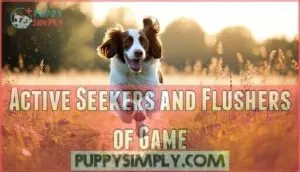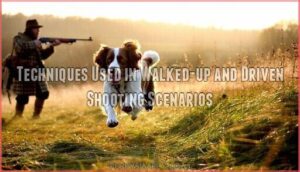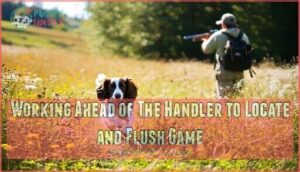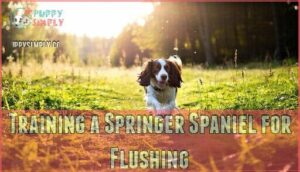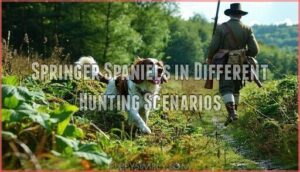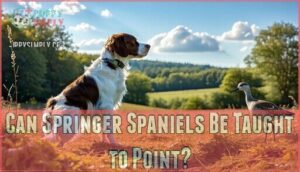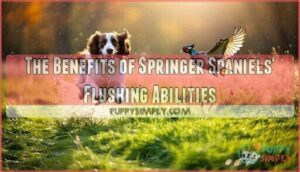This site is supported by our readers. We may earn a commission, at no cost to you, if you purchase through links.
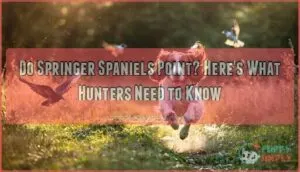
While pointing breeds like English Setters freeze when detecting game, springer spaniels systematically quarter through cover and immediately flush birds upon scent detection.
This flushing instinct runs so deep that most working springers show minimal pointing behavior, even when exposed to game.
Though some can be trained to point with early, consistent effort, success depends heavily on individual genetics and training methods.
Most hunters work with their springer’s natural abilities rather than against them, since these energetic dogs excel at what they were bred for, making them invaluable hunting partners.
Understanding how to harness their flushing prowess reveals why they’re invaluable hunting partners.
Table Of Contents
- Key Takeaways
- Understanding Springer Spaniel Hunting Abilities
- The Role of Springer Spaniels in Flushing Game
- Training a Springer Spaniel for Flushing
- Springer Spaniels in Different Hunting Scenarios
- Can Springer Spaniels Be Taught to Point?
- The Benefits of Springer Spaniels’ Flushing Abilities
- Choosing The Right Hunting Companion: Springer Spaniels Vs. Pointers
- Frequently Asked Questions (FAQs)
- Are Springer Spaniels good hunting dogs?
- What is a springer spaniel?
- How good is a pointing English Springer Spaniel?
- Are English Springer Spaniels easy to train?
- What do English Springer Spaniels do?
- What if you’ve never hunted over a springer spaniel?
- Are Springer Spaniels pointing dogs?
- Why does my spaniel point?
- Do Spaniels point or flush?
- What are the behavioral problems with Springer Spaniels?
- Conclusion
Key Takeaways
- You can’t rely on Springer Spaniels to point naturally – they’re bred as flushing dogs that actively pursue and startle game into flight, not freeze like traditional pointing breeds
- Training them to point is possible but difficult – while some can learn basic pointing with early, consistent training, their flushing instincts remain dominant and they’ll never match dedicated pointing breeds
- They excel at what they’re naturally built for – Springers are exceptional at working within 30-35 yards, quartering through dense cover, and immediately flushing birds for shooting opportunities
- You’ll get better results working with their strengths – embracing their natural flushing abilities and energy makes them invaluable hunting partners rather than forcing them into unnatural pointing behaviors
Understanding Springer Spaniel Hunting Abilities
If you’re wondering whether your Springer Spaniel can point like a traditional bird dog, the answer isn’t straightforward.
These versatile hunting companions excel at flushing and retrieving game, but pointing isn’t their natural forte—though they can be trained for it with varying degrees of success.
Versatile Hunting Skills Across Flushing and Retrieving Game
When you’re evaluating the springer spaniel breed for hunting, you’ll discover their remarkable adaptability across diverse hunting scenarios.
These versatile hunting companions adapt brilliantly to any terrain you’ll encounter in the field
These versatile gundogs demonstrate exceptional proficiency in multiple hunting tactics, making them valuable companions for various terrain adaptation challenges.
Here’s what makes springer spaniels excel in the field:
- Game Retrieval Excellence – They track wounded birds through thick cover using their developed scenting abilities
- Flushing Techniques Mastery – Unlike dog pointing breeds, they naturally spring birds into flight for shooting opportunities
- Terrain Adaptation Skills – From wetlands to uplands, they navigate challenging environments with stamina and agility
- Breed Comparison Advantages – While pointing dog breeds excel at indicating game location, springer spaniel training focuses on active flushing game for immediate shooting chances
This combination of skills makes them particularly effective in walked-up shooting and driven hunts where flushing game takes priority over pointing behaviors.
Differences Between Pointing and Flushing Breeds
Understanding breed comparison between pointing dog breeds and flushing specialists reveals fundamental differences in hunting styles.
Pointing breeds like English Setters demonstrate instinctive pointing behavior, freezing motionless when detecting game to signal location.
These pointing dog breeds possess genetic pointing instincts that emerge naturally.
Conversely, flushing breeds excel at different flushing techniques, actively pursuing and startling birds into flight.
Breed specificity determines whether your dog will pause and point or immediately flush game.
This distinction affects hunting strategies substantially, as pointing instinct allows hunters preparation time while flushing game creates immediate shooting opportunities requiring quick reflexes.
Hunters should consider the importance of breed specific training to optimize their dog’s performance in the field, focusing on breed specific needs and pointing instinct to enhance their hunting experience with flushing techniques.
Springer Spaniels’ Natural Inclination for Flushing Game
Springer Spaniels demonstrate remarkable flushing game instincts bred over centuries for upland hunting.
Their breed characteristics include tireless energy and adaptability across diverse terrain adaptation scenarios.
Unlike dog pointing behavior seen in setters, these spaniel dog types excel at active pursuit and game retrieval.
Their hunting styles involve systematic quartering patterns, using scent detection to locate birds before explosive flushes.
The dog pointing instinct remains minimal in working lines, with flushing techniques taking precedence.
These behavioral patterns make them invaluable partners for walked-up shooting, where their natural drive transforms dense cover into productive hunting opportunities through specialized flushing game strategies.
The Role of Springer Spaniels in Flushing Game
If you’re wondering whether Springer Spaniels naturally point like setters or pointers, the answer is straightforward: they don’t.
These energetic hunters excel as active flushers, using their keen noses and boundless drive to locate game and spring it into flight for waiting guns.
Active Seekers and Flushers of Game
Unlike traditional pointers that freeze upon detecting game, your springer spaniel’s hunting instincts drive them to actively seek and flush birds into flight.
Their superior scent detection abilities and terrain adaptability make them exceptional hunting companions who work tirelessly ahead of handlers.
- Quartering patterns – Your dog systematically sweeps back and forth, covering maximum ground while maintaining ideal distance
- Wind utilization – They instinctively work into the wind, maximizing their scent detection capabilities for locating hidden game
- Immediate flush response – Upon finding birds, they spring into action, forcing game into flight rather than holding a static point
Techniques Used in Walked-up and Driven Shooting Scenarios
When you’re out in the field, your Springer Spaniel becomes a master of tactical game location and scent tracking.
These dogs excel in both walked up shooting and driven shooting scenarios through specialized hunting techniques that maximize effectiveness.
| Shooting Method | Dog Handling Approach | Terrain Navigation | Flushing Game Strategy |
|---|---|---|---|
| Walked-Up | Work 30-35 yards ahead | Dense woodland cover | Wind-assisted quartering |
| Driven Shoots | Beating line formation | Moorland advancement | Coordinated game pushing |
Your spaniel’s natural flushing game instincts shine during these operations.
Unlike pointing behavior seen in setters, Springers actively seek and flush birds within seconds of detection.
Their shooting tactics involve systematic terrain sweeps, using wind patterns for ideal scent tracking while maintaining close communication with handlers throughout the hunt.
Working Ahead of The Handler to Locate and Flush Game
Your Springer works as your eyes and nose in the field, ranging 30 to 35 yards ahead while maintaining constant communication through body language and positioning.
Your Springer becomes your trusted field partner, eyes sharp and nose working, always within perfect shooting range
This systematic approach to Game Location and Terrain Navigation maximizes coverage while keeping your dog within effective shooting range for ideal Flushing Techniques.
Here’s how your Springer operates ahead of you:
- Scent Tracking patterns – Works into the wind, quartering back and forth to catch airborne scent particles
- Handler Communication – Responds to whistle commands and hand signals while maintaining forward momentum
- Hunting instincts activate – Tail movement increases and body posture shifts when detecting game presence
- Flushing game execution – Creates explosive bird flight within your shooting zone rather than exhibiting pointing behavior
Training a Springer Spaniel for Flushing
Training your Springer Spaniel for effective flushing requires building a foundation of obedience commands that keep your dog working within range while maintaining their natural enthusiasm for the hunt.
You’ll need to focus on teaching proper quartering patterns, steady flushing behavior, and reliable retrieval skills that utilize their exceptional scenting ability to track wounded game through various terrain and wind conditions.
Developing Obedience and Proximity Commands
Foundation commands create the backbone of effective hunting partnerships.
Start with basic obedience commands like "sit," "stay," and "come" before advancing to proximity training.
Distance control becomes essential when your spaniel works 30-35 yards ahead during walked-up shoots.
Practice recall techniques using whistle signals and hand gestures for silent communication.
Leash manners teach proper heel position, preventing your dog from ranging too far.
These dog training tips establish the groundwork for successful flushing work in the field, using basic obedience commands.
Teaching Proper Flushing Techniques and Retrieval Behaviors
Mastering flushing techniques requires systematic training that builds on your springer spaniel’s natural instincts. Start with basic recall commands, then progress to controlled flushing exercises using planted birds or scent trails. Focus on timing – your dog should flush immediately upon locating game, not hesitate or attempt pointing behaviors.
- Proximity Training: Teach your springer to work within 30-35 yards, maintaining visual contact while quartering effectively
- Flush Command: Use consistent verbal cues like "hunt" or "get up" to encourage immediate game displacement
- Steady Training: Practice "hup" commands to stop your dog after flushing, preventing chase behaviors that scatter remaining birds
- Retrieval Markers: Train your spaniel to mark fallen game locations and deliver softly to hand without dropping
- Scent Discrimination: Expose your dog to various game bird scents during training sessions to improve game location accuracy
Having the right Springer Spaniel Gear is essential for successful training and hunting experiences. Consistent practice with live birds develops reliable flushing game performance and strengthens handler communication essential for successful hunting partnerships.
Utilizing Scent and Wind to Track and Retrieve Injured Game
When training your Springer Spaniel for scent tracking and game retrieval, wind direction becomes your dog’s compass.
These natural trackers excel at reading environmental cues to locate wounded birds that might otherwise escape. Your spaniel’s scent detection abilities allow them to follow fading trails through diverse terrain navigation challenges.
During retriever trials, observe how your dog processes airborne particles:
- Quartering technique: Working systematically across wind patterns to maximize scent contact
- Backtracking behavior: Following scent trails when initial flushing game attempts fail.
Unlike pointing behavior found in specialized breeds, Springer Spaniels use continuous nose work rather than freezing at game locations. This hunting strategy makes them invaluable partners for tracking injured waterfowl through marshes or upland birds across varied terrain.
Springer Spaniels in Different Hunting Scenarios
Springer Spaniels excel in diverse hunting scenarios, adapting their flushing techniques to match specific terrain and game conditions.
You’ll find these versatile dogs working effectively in walked-up shooting, grouse hunting alongside pointing breeds, and beating lines during driven shoots.
Walked-up Shooting: Hunting in Front of The Gun Using Scent and Wind
Your spaniel’s hunting prowess shines during walked-up shooting, where scent work becomes paramount.
Reading wind direction helps your dog locate game effectively using natural scent detection abilities.
These hunting spaniels excel at flushing game within 30-35 yards ahead, utilizing proven flushing techniques.
Their hunting strategies differ from pointing behavior, making them ideal for this dynamic shooting style.
Effective spaniel training requires understanding of dog behavior patterns to maximize their potential in the field, which is crucial for successful training.
Grouse Hunting: Navigating Thicker Cover Alongside Bird Dogs
When you’re out on the moorland hunting grouse, Springer Spaniels shine in thick cover where traditional bird dogs struggle.
Their compact build and relentless drive help them navigate dense heather and brambles that would slow pointing breeds.
While bird dog tactics rely on freezing to mark game location, Springer Spaniels use different grouse habitat strategies.
They work methodically through heavy cover, using their superior scenting ability to locate birds.
Once they find grouse, their natural flushing behavior creates immediate shooting opportunities, making them invaluable partners in challenging moorland hunting conditions.
Beating Line: Pushing Game Towards The Guns in Driven Shoots
During driven shoots, you’ll position your Springer along beating lines where they excel at pushing game toward strategically placed guns.
These dogs work systematically through cover, using their natural flushing instincts to drive birds forward rather than pointing behavior.
- Coordinated movement: Dogs advance in organized lines with beaters, maintaining proper spacing for effective game pushing
- Strategic positioning: Gun placement relies on predictable flush tactics as Springers drive birds toward waiting shooters
- Cover penetration: These spaniels navigate dense vegetation where pointing breeds might struggle, ensuring thorough area coverage
- Team synchronization: Multiple dogs work together in beating lines, creating consistent pressure that moves game efficiently toward guns
Can Springer Spaniels Be Taught to Point?
While Springer Spaniels are bred for flushing game rather than pointing, you can train them to exhibit pointing behavior with early and consistent training.
However, their natural flushing instincts remain dominant, making them less reliable pointers compared to breeds specifically developed for this behavior.
Inherent Flushing Instincts Vs. Pointing Abilities
Genetics play the starring role in determining your Springer Spaniel’s hunting behavior. These dogs carry centuries of selective breeding for flushing game, not pointing instincts.
Field studies confirm that Springer Spaniels possess genetic markers favoring rapid movement and engagement with cover, making sustained pointing behavior incompatible with their natural temperament. While you might occasionally observe brief hesitation before flushing, this differs fundamentally from the classic freeze exhibited by pointing breeds.
Breed comparison reveals that flushing techniques dominate their hunting styles, with less than 10% showing spontaneous pointing behavior in controlled experiments.
To improve their hunting performance, owners can focus on teaching dogs to respond to commands and obey instructions in the field, which is crucial for their hunting performance.
Possibility of Training Springer Spaniels to Exhibit Pointing Behavior
While Springer Spaniels don’t naturally point like traditional pointing breeds, you can train them to exhibit brief pointing behavior with dedicated effort.
Training methods focusing on scent rewards and positive reinforcement can shape their natural pause before flushing into a more defined point. However, breed limitations mean this behavior won’t match specialized pointing breeds’ intensity or duration.
Individual Canine Genetics play a role—some Springers show stronger pointing behavior variations than others. Success depends on starting early, consistent practice, and realistic expectations.
Most hunters find their Flushing Instincts more valuable than forcing unnatural Pointing Techniques onto these naturally gifted flushers.
Factors to Consider When Training for Pointing Vs. Flushing
When deciding between training methods for pointing versus flushing, several key factors shape your dog’s success.
Individual breed instincts heavily influence whether your Springer will respond better to flushing techniques or pointing styles.
Consider your hunting strategies and terrain requirements, as dense cover favors natural flushing behaviors while open fields suit pointing breeds.
Training methods must align with your dog’s genetic predisposition for ideal results.
Key considerations include:
- Genetic lineage – Field-bred lines show stronger flushing instincts than pointing behavior
- Training timeline – Early exposure to pointing styles may create momentary hesitation but rarely solid points
- Hunting terrain – Dense cover rewards active flushing while open areas benefit from steady pointing
- Game species – Fast-moving birds like pheasant favor immediate flush over prolonged pointing
- Handler experience – Dog pointing training requires different skills than reinforcing natural flushing techniques
The Benefits of Springer Spaniels’ Flushing Abilities
While Springer Spaniels don’t naturally point like specialized pointer breeds, their flushing abilities offer distinct advantages that make them exceptional hunting companions.
You’ll find these energetic dogs excel in scenarios where quick action and close-quarters work prove more valuable than the patient pointing style of setters and pointers, making them ideal for hunting.
Effective in Close-quarters Hunting Scenarios
When you’re hunting in tight spaces, your Springer’s flushing instincts become a game-changer.
Unlike pointing behavior that requires open terrain, these dogs excel at scent tracking through dense brush where game retrieval demands quick reflexes.
Their hunting dynamics shift from slow stalking to rapid terrain navigation, making close quarters their specialty rather than traditional dog pointing position scenarios.
- Thick cover advantage: Springers navigate brambles and undergrowth where pointing breeds struggle to maintain position
- Rapid game location: Their scent tracking abilities allow quick target identification in confined hunting scenarios
- Instant flushing response: No waiting for pointing behavior – they locate, flush, and retrieve in one fluid hunting tactic
Agility and Adaptability in Dense Covers
When thick brambles and dense woodland challenge other hunting dogs, your springer spaniel breed thrives through superior Dense Cover Navigation and Terrain Adaptability.
Their compact Spaniel Physique enables efficient movement through tight spaces where larger hunting dogs struggle.
Enhanced Scent Tracking abilities help locate game in challenging conditions, while their natural flushing instincts maintain Hunting Efficiency regardless of environmental obstacles.
Valuable Contributions to Shooting Teams and Hunting Experiences
Why do shooting teams value Springer Spaniels so much? Their exceptional flushing instincts and team dynamics make them indispensable hunting dogs in field operations.
These gun dogs excel through:
- Scent work precision – detecting game others miss in dense terrain
- Game retrieval reliability – bringing back wounded birds efficiently
- Terrain adaptation skills – traversing varied hunting environments seamlessly
Unlike pointing breeds, Springer Spaniels’ active flushing approach creates dynamic hunting strategies that keep shooting teams engaged and successful.
Their natural ability as water retrievers also enhances their overall performance in hunting environments.
Choosing The Right Hunting Companion: Springer Spaniels Vs. Pointers
Selecting the ideal hunting companion depends on your preferred hunting style and target game species.
Springer Spaniels excel in close-range flushing scenarios, while pointing breeds like Setters and German Shorthaired Pointers provide strategic game location through their instinctive freezing behavior, which aids in strategic game location.
Evaluating Personal Hunting Preferences and Needs
Before choosing your hunting companion, you’ll want to assess your personal hunting preferences honestly.
Do you thrive on fast-paced action where birds flush quickly, or do you prefer the anticipation of watching a dog hold point?
Your hunting needs directly influence breed considerations.
Springer Spaniels excel in dynamic hunting styles that require immediate response and versatility.
If you’re drawn to walked-up shooting through dense cover, their flushing abilities shine.
However, hunters who enjoy the strategic pause that pointing breeds provide might find different satisfaction.
Understanding the best hunting dog breeds for tracking is essential for a successful hunt, utilizing tracking dog techniques.
| Factor | Springer Spaniels |
|---|---|
| Hunting Styles | Fast-paced flushing |
| Terrain Choice | Dense cover, varied ground |
| Game Selection | Multiple species, close-quarters |
Understanding The Distinct Roles and Capabilities of Each Breed
When selecting between Springer Spaniels and pointing breeds, you’re choosing between fundamentally different hunting approaches.
Springer Spaniels excel as flushing breeds, designed for close-quarters work within gun range, while pointing breeds like German Shorthaired Pointers range farther and hold static points.
This breed comparison reflects distinct breed history and hunting styles. Understanding the dog breed characteristics is essential for effective training and utilization of these dogs in hunting scenarios.
| Aspect | Springer Spaniels | Pointing Breeds |
|---|---|---|
| Primary Role | Flushing and retrieving game | Locating and pointing at game |
| Working Distance | 30-35 yards from handler | Extended range beyond gun range |
| Hunting Technique | Active quartering, immediate flush | Static point, wait for hunter |
| Terrain Specialty | Dense cover, thick woodland | Open landscapes, wide terrain |
Understanding these dog pointing characteristics helps match your dog training approach to each breed’s natural instincts.
Flushing techniques work best when they align with your Springer’s genetic programming for rapid game displacement.
Considering The Hunting Terrain and Game Species for Optimal Results
Your hunting success hinges on matching your dog’s abilities to your terrain and target species.
Dense woodland suits Springer Spaniels’ flushing prowess, while open fields favor pointing breeds for distant game detection.
| Terrain Type | Springer Spaniels | Pointing Breeds |
|---|---|---|
| Dense Cover | Excellent for pheasant, woodcock | Limited visibility reduces effectiveness |
| Open Fields | Requires wider range, less optimal | Superior for quail, grouse location |
| Wetlands | Outstanding waterfowl retrieval | Good pointing, limited water work |
Consider game behavior when selecting your hunting companion for ideal conditions and hunting success.
Frequently Asked Questions (FAQs)
Are Springer Spaniels good hunting dogs?
Yes, Springer Spaniels are excellent hunting dogs.
They excel at flushing and retrieving game with high energy, intelligence, and strong scenting ability, making them valuable hunting companions across diverse terrains.
What is a springer spaniel?
Like a Swiss Army knife designed for the field, you’ll find a Springer Spaniel is a versatile English gundog bred specifically for flushing and retrieving game from dense cover.
Combining athletic ability with intelligent partnership.
How good is a pointing English Springer Spaniel?
English Springer Spaniels aren’t naturally strong pointers.
While you can train them to point with early, consistent training, they’ll never match dedicated pointing breeds like Brittanys or German Shorthairs in reliability and intensity.
Are English Springer Spaniels easy to train?
You’ll find Springer Spaniels highly trainable due to their intelligence and keenness to please.
Their strong work ethic and food motivation make them respond well to consistent, positive training methods throughout their lives, leveraging their intelligence.
What do English Springer Spaniels do?
English Springer Spaniels excel as versatile hunting companions, specializing in flushing and retrieving game from dense cover.
You’ll find they’re energetic, intelligent workers who thrive on tracking, finding, and retrieving birds for hunters across diverse terrains.
What if you’ve never hunted over a springer spaniel?
Like stepping into uncharted territory, you’ll discover their natural flushing instincts firsthand.
Springer Spaniels work close-range, typically hunting within thirty-five yards, using scent-driven behavior to locate and flush game rather than pointing.
Are Springer Spaniels pointing dogs?
No, Springer Spaniels aren’t pointing dogs.
They’re natural flushers bred to find and flush game, not freeze and point at it like setters or pointers.
While you can train them to pause briefly, it’s not their primary hunting instinct or strength.
Why does my spaniel point?
Your spaniel’s pointing behavior stems from ancestral hunting genetics bubbling to the surface.
While Springer Spaniels aren’t natural pointers like setters or German Shorthairs, they retain dormant pointing instincts from their sporting dog heritage that occasionally emerge during play or hunting situations.
Do Spaniels point or flush?
Both behaviors exist, but your spaniel’s breed determines which one they’ll naturally favor.
Flushing breeds like English Springer Spaniels actively seek and chase game into flight, while pointing breeds freeze to indicate prey location before you approach.
What are the behavioral problems with Springer Spaniels?
Imagine your energetic companion bouncing off walls like a pinball machine – that’s separation anxiety in action.
You’ll encounter destructive chewing, excessive barking, hyperactivity, and potential aggression when they’re understimulated or inadequately exercised daily.
Conclusion
Like a compass needle naturally finding magnetic north, springer spaniels instinctively gravitate toward flushing rather than pointing behavior.
While training can potentially modify this natural tendency, working against their genetic programming often proves counterproductive.
These energetic dogs excel as systematic game-finders, quartering through cover with remarkable efficiency.
Rather than forcing unnatural pointing behaviors, you’ll achieve better results by embracing their flushing expertise.
Do springer spaniels point? Rarely by nature, but they don’t need to—their flushing abilities make them exceptional hunting partners, showcasing their value as hunting partners.

